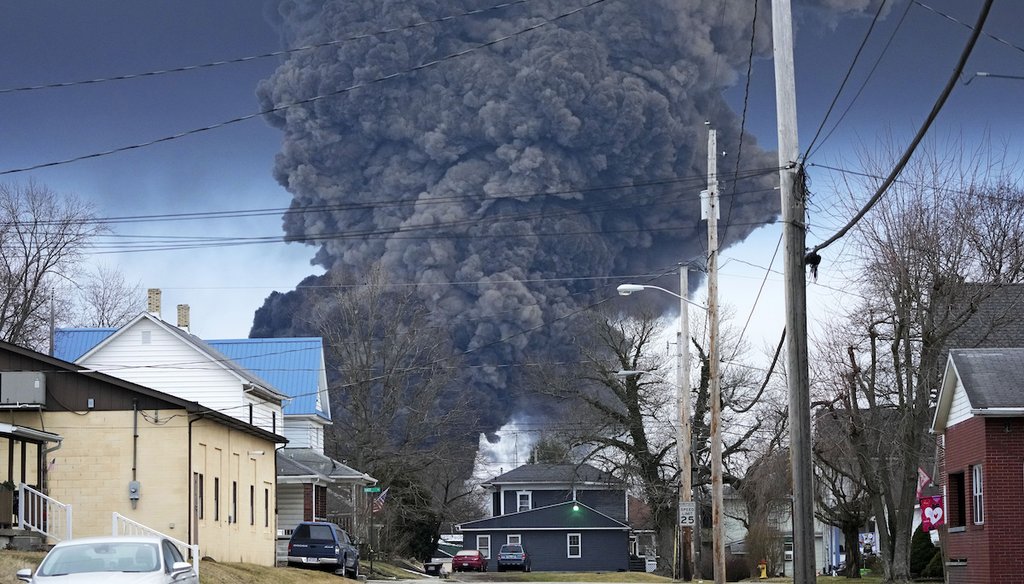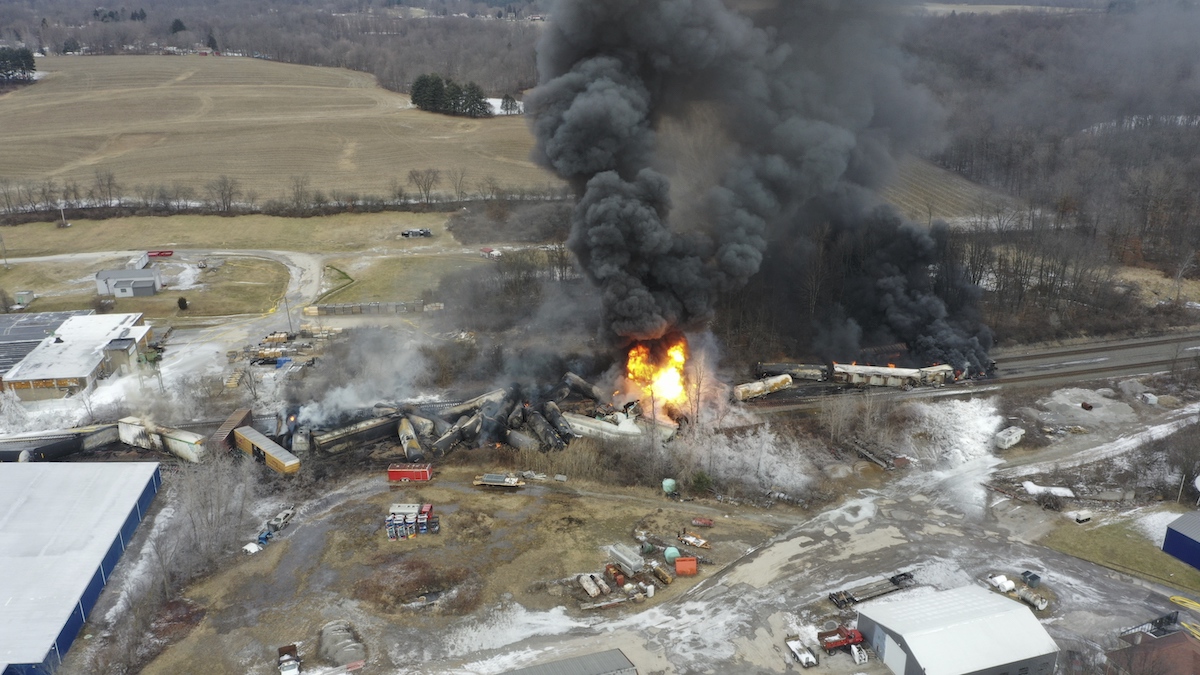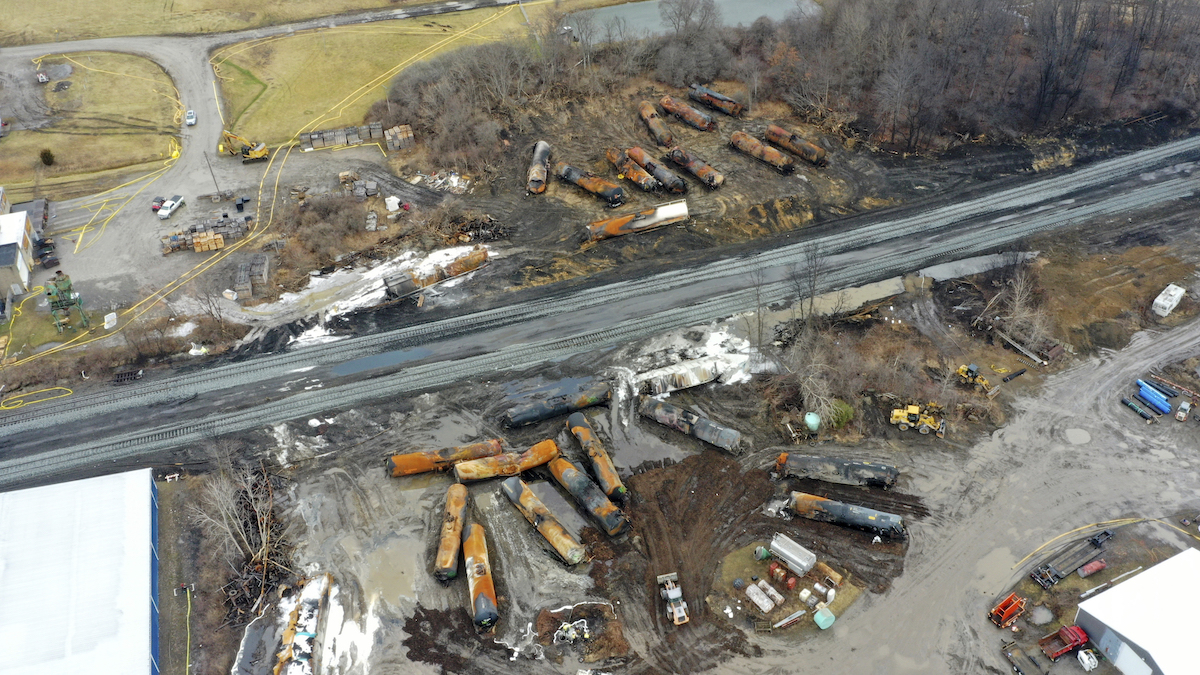Get PolitiFact in your inbox.

A black plume rises over East Palestine, Ohio, as a result of a controlled detonation of a portion of a derailed Norfolk Southern trains on Feb. 6, 2023. (AP)
A disastrous train derailment in a small Ohio town has left many of the area’s residents concerned about public safety and the environment.
On Feb. 3, a Norfolk Southern freight train derailed around 9 p.m. in East Palestine, Ohio, a village of about 4,700 people near the Pennsylvania border, about an hour northwest of Pittsburgh. The train had been traveling from Madison, Illinois, to Conway, Pennsylvania.
About 38 of the train’s 150 cars ran off the tracks, damaging an additional 12 cars. Officials said five cars contained vinyl chloride, a toxic, flammable gas used to make plastic products. The derailment’s cause remains under investigation.
The situation is worrisome, and investigations into the effects for the people closest to the disaster, from the chemical spill and a subsequent controlled chemical burn, are just getting started.
Social media users have been posting extensively about the disaster, claiming it is among the worst catastrophes in history, with some going so far as to compare it with the Chernobyl nuclear plant disaster.
So far, there are no confirmed deaths from the derailment, which sets it apart from dozens of industrial accidents in recent U.S. history. However, illnesses can take time to develop. So can local environmental impacts.
For now, local and state officials have said air and water quality tests show low levels of contamination. A few thousand fish have died from contaminated water, but food supplies and livestock remain at low risk, the Ohio Department of Agriculture said.
Thomas A. Birkland, a North Carolina State University public policy professor, told PolitiFact the incident is "concerning" and urged East Palestine residents to follow protocols set by public health and environmental agencies.
Even so, he added, the derailment is "unlikely" to become as bad as the 1986 Chernobyl nuclear plant disaster in what today is Ukraine. Chernobyl was a radioactive incident that killed several dozen workers directly, forced the evacuation of roughly 100,000 civilians, and led to the creation of a depopulated, 19-mile-radius exclusion zone around the former plant.
"There's no reason to believe that this is going to happen in Ohio," Birkland said.
Nor is the derailment likely to turn East Palestine into a new Bhopal, the city in India in which a 1984 industrial gas leak killed thousands of people and injured half a million more, leaving some blinded or with serious respiratory deficits.
The derailment is "not good, but not apocalyptic," said Michel Bruneau, distinguished professor in the Civil, Structural and Environmental Engineering department at the University at Buffalo. "This is not Bhopal."
Still, many are concerned about the train’s toxic cargo and the railroad company’s decision to burn the chemicals rather than risk an explosion.
This photo, taken with a drone, shows portions of a Norfolk Southern freight train that were still on fire some 24 hours after a derailment in East Palestine, Ohio. (AP)
After the train derailed, a large fire erupted, sending a huge plume of smoke skyward. Officials warned of the risk of an explosion triggered by hazardous chemicals and combustible materials aboard the train. The chemical of primary concern was vinyl chloride.
Govs. Mike DeWine, R-Ohio, and Josh Shapiro, D-Pa., ordered an immediate evacuation of about 1,500 to 2,000 residents who lived within a 1-by-2 mile area surrounding the incident, which included parts of both states.
To prevent an explosion, Norfolk Southern Railway Co., a Norfolk Southern Corp. subsidiary and the train’s operating company, carried out a controlled burn of the vinyl chloride, a carcinogen, on Feb. 6. The burning sent hydrogen chloride and phosgene into the air, and a billowing black smoke cloud from the burn site could be seen for miles.
DeWine said during a Feb. 14 press conference that he learned that day from the Public Utilities Commission of Ohio that the Norfolk Southern train was not considered a high-hazardous material train because some cars did not contain such materials. As a result, the railroad company was not required to notify the state of what was being transported.
DeWine called this "absurd" and urged Congress to reassess regulations for trains carrying toxic substances.
Two days after the controlled burn, officials told evacuated residents it was safe to return home. State and local health officials analyzed air quality samples from the derailment area and nearby residential neighborhoods and found the contaminants below the level of concern.
But some environmental advocates criticized this decision. David Masur, executive director of PennEnvironment, an environmental advocacy group headquartered in Philadelphia, told PolitiFact he was "very skeptical of the speed at which regulators and state officials and agencies gave the green light for residents to go back." To Masur, it violated the "do no harm" principle of medical ethics.
Michael G. Koehler, principal scientist with Professional Analysis and Consulting, a company based in Lisle, Illinois, shared Masur’s concern.
"The typical approach is to monitor the air, water, and soil to establish the environmental fate of the spill," he said. "This is not a once-and-done monitoring but should be done long-term to establish the contaminants transport in the soil, aquifers, and waterways."
There have been no reports of injuries or deaths from the derailment as of Feb. 15. Some East Palestine residents have said they experienced skin irritations, respiratory problems and other negative health effects since returning home.
State health officials encouraged people with these symptoms to contact their medical providers and call the local hotline to alert officials so a team can analyze their environment.
As of Feb. 13, the U.S. Environmental Protection Agency had completed indoor air screenings in 396 homes, with 100 homes remaining. In the homes screened so far, the agency said, "no detections of vinyl chloride or hydrogen chloride were identified." The EPA said it will continue community air monitoring.
The EPA is also monitoring water quality. Officials told the affected area’s residents to use bottled water until testing could confirm that local water supplies are safe to drink.
This photo, taken with a drone on Feb. 9, 2023, shows the continuing cleanup of portions of a Norfolk Southern freight train that derailed in East Palestine, Ohio. (AP)
Several social media posts claim dead fish and cattle have been found as far as 100 miles from the derailment site. Officials said they have not received reports of such widespread impacts on wildlife and have said the environmental impact is continually being assessed.
The Ohio Department of Natural Resources told PolitiFact that dead fish have been found in Leslie Run, Bull Creek and a portion of the North Fork of Beaver Creek. As of Feb. 8, the department estimates the chemical spill has killed 3,500 fish across 7.5 miles of streams. The dead fish have mostly been small suckers, minnows, darters and sculpin.
State officials are tracking a large plume of contamination from the chemical spill traveling down the Ohio River. The plume is diluting as it travels and it is not expected to taint the water supplies of communities along the Ohio River, Tiffani Kavalec, head of surface water at the Ohio EPA, said during a Feb. 14 press conference.
The Ohio Department of Agriculture said the state's food supply is safe and the risk to livestock remains low following the train derailment. The department has received no official reports of animal illnesses or deaths related to the derailment or controlled chemical burn.
The Ohio EPA also said during the press conference that soil sampling continues in the area where there was controlled release of chemicals.
Absent answers, there is a lot of speculation about the scale of the East Palestine derailment. Many residents have taken to Facebook groups to share information about the disaster. A town hall meeting for the East Palestine community is scheduled for the night of Feb. 15.
Birkland, the North Carolina State professor, said some of the social media claims are questionable or flat-out wrong. For instance, he said, there is "no evidence" the disaster will reach deep into Ohio, West Virginia, Kentucky and Pennsylvania, despite social media posts that warned otherwise.
Where this accident will rank among U.S. industrial and environmental disasters remains to be seen.
Joana Gaia, clinical assistant professor in the University at Buffalo’s management science and systems department, suggested that exaggerated claims can fill a vacuum when there is little confirmed information and a constantly evolving situation.
"From a news reporting perspective, we are not in an underreporting situation, but rather almost in a waiting pattern for the situation to change," she said. "It is natural that people in the surrounding areas that have been affected by this are more vocal and try to bring attention to the situation. This is still a major environmental disaster that can have consequences for years or decades to come, and from that perspective it is a major event that will likely occur again."
CORRECTION, Feb. 20: We corrected the name of one of the gases released into the air during the controlled burn of vinyl chloride. It is phosgene.
RELATED: Ohio derailment is just the latest serious industrial accident in the U.S.
RELATED: We’ve seen reports of three train derailments this month. Is this normal?
Our Sources
Press conference, various Ohio state and local officials, Feb. 14, 2023
Interview with David Masur, executive director of PennEnvironment, Feb. 14, 2023
Email interview with Michael G. Koehler, principal scientist with Professional Analysis and Consulting, Feb. 15, 2023
Email interview with Meghan Harshbarger, spokesperson for the Ohio Department of Agriculture, Feb. 14, 2023
Email interview with Stephanie O’Grady, spokesperson for the Ohio Department of Natural Resources, Feb. 13, 2023
Email interview with Thomas A. Birkland, public policy professor at North Carolina State University, Feb. 14, 2023
Email interview with Michel Bruneau, distinguished professor in the department of civil, structural and environmental engineering at the University at Buffalo, Feb. 15, 2023
Email interview with Joana Gaia, clinical assistant professor in the department of management science and systems at the University at Buffalo, Feb. 15, 2023
Other sources linked in article





































